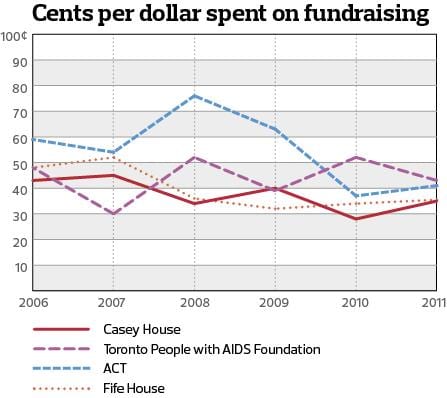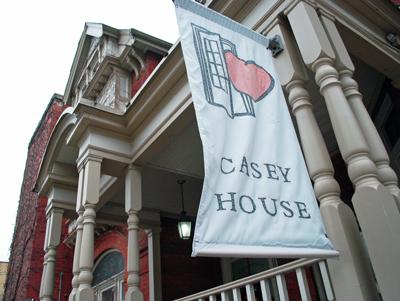
Credit: Rob Salerno
NOTE: This story has been updated on Dec 22 to include 2011 financial information for Fife House, which was unavailable at press time.
DEC 8: Earlier this fall a reader asked Xtra to look into fundraising at Casey House. The organization’s 2011 annual report lists fundraising and special events expenses of just over $1 million on special events revenues of only $1.15 million. Why, asked our reader, should anyone attend Casey House’s annual gala events if 85 percent of the money raised goes to pay for the events themselves?
The truth, says Stephanie Karapita, CEO of Casey House, is not so simple. The organization’s reported fundraising costs include $107,033 for startup costs of its $10-million capital campaign, $409,229 for general fundraising costs, and $485,774 toward the costs of Casey House’s three annual events: The Snow Ball, Art with Heart and Voices of Hope.
Casey House actually reported a 42 percent cost/revenue ratio for its special events in 2011, down from 47 percent in 2010. Karapita says that the organization intends to get that number below 40 percent going forward and that the numbers from this year’s Art with Heart and Voices of Hope fundraisers put the organization in shape to meet that target. Karapita did, however, refuse to provide Xtra’s readers with detailed accounts for the individual events.
“Casey House fulfills its accountability to donors through publication on our website of our annual report, financial statements and balanced scorecard,” she says.
The organization’s other fundraising activities, such as direct mail and planned giving, generate a further $1.4 million, according to its annual report. That gives Casey House an overall fundraising cost/revenue ratio of approximately 35 percent.
According to the federal Income Tax Act, charitable organizations are supposed to spend everything they earn on charitable acts, but the Canada Revenue Agency (CRA) allows charities to spend money on their fundraising. While there is no official limit to the fundraising cost/revenue ratio enforced by the CRA, its website states that ratios under 35 percent do not raise alarms at the agency. The CRA examines trends over several years if the ratio exceeds that number, but red flags are not raised unless the ratio exceeds 70 percent.
Xtra compared detailed financial statements filed with the CRA by Casey House with the reports of several other Toronto AIDS service organizations. We found that the fundraising cost/revenue ratio for Casey House is in line with the other major groups. While Fife House has held its ratio at or below 35 percent in recent years, the AIDS Committee of Toronto (ACT) and the Toronto People with AIDS Foundation have both had much higher cost/revenue ratios in recent years (see chart).
ACT’s cost ratio was pushed up by the very expensive annual Fashion Cares gala, which the organization discontinued after a disastrous 2008 year. Since 2010, ACT’s ratio has fallen to a more reasonable 40 percent, and ACT director of development Daniel Knox wants to get that even lower. He wants to encourage more individual donations and bequests.
“By giving a donation straight to the agency, you’re doing more than attending an event,” he says. “More of your dollar will go to good works.”
It’s not uncommon or unacceptable for a gala event to cost a lot of money for a charity to run, he says. ACT’s annual AIDS Walk for Life and SNAP events cost between 40 and 45 cents for every dollar earned.
“Typically for a large gala, if you’re looking at 50 cents to 60 cents on the dollar, that’s within the industry standard,” says Knox. “A major gifts program will cost three to five cents on the dollar.”
Karapita says Casey House relies on donations to run its homecare program, for which it receives no government funding. The province fully covers in-patient care.
“At this point the board is committed to special events, but the long-term plan is to move toward more major gift fundraising. The capital campaign is the start of that,” she says.
Casey House recently announced the launch of a $10-million capital campaign to help finance the construction of a larger new facility fronting on Jarvis St, which would be better equipped for its hospice patients. There will also be a day health program and a centre for excellence in treatment for people living with HIV.
While the province has committed a portion of the costs, up to $29 million for the project, Casey House is responsible for raising the balance. Karapita predicts the new building will help to improve service and will relieve pressure on the province’s healthcare system by giving people living with HIV access to less costly options for treatment than emergency-room visits, hospital admissions and psychiatric counselling.
The capital campaign is not being funded from Casey House’s annual gala events. It is being chaired on a volunteer basis by Jaime Watt, of the political communications firm Navigator. Casey House hired the Offord Group on a time-limited contractual basis to help set up the capital campaign this year.
While charities always face costs associated with fundraising, it appears that to ensure their gifts make the greatest impact, donors should give directly to a charity, rather than spend money on tickets to a major event.
Making a donation through an online portal like canadahelps.org means very low overhead for the charity. And given the current economic and political situation, AIDS charities need all the help they can get.
“When we’re looking at potential impact of city cuts and a federal government that has not always shown a commitment to HIV/AIDS, now is an important time to focus on our local groups,” Knox says.


 Why you can trust Xtra
Why you can trust Xtra


